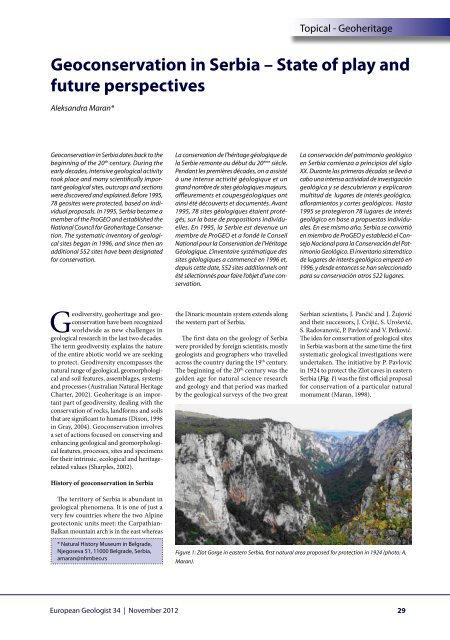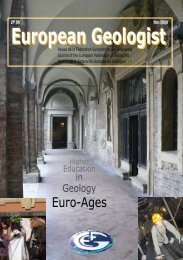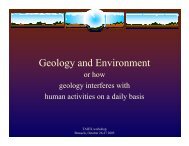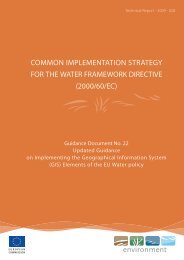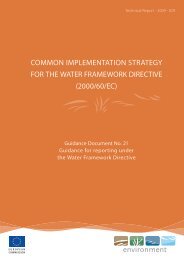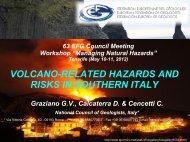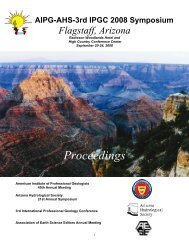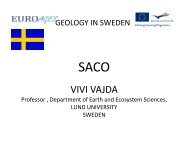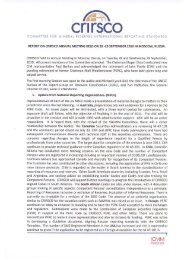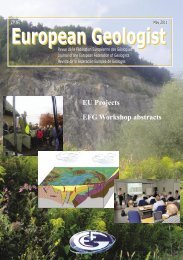European Geologist European Geologist Geoheritage - learning ...
European Geologist European Geologist Geoheritage - learning ...
European Geologist European Geologist Geoheritage - learning ...
You also want an ePaper? Increase the reach of your titles
YUMPU automatically turns print PDFs into web optimized ePapers that Google loves.
Topical - <strong>Geoheritage</strong><br />
Geoconservation in Serbia – State of play and<br />
future perspectives<br />
Aleksandra Maran*<br />
Geoconservation in Serbia dates back to the<br />
beginning of the 20 th century. During the<br />
early decades, intensive geological activity<br />
took place and many scientifically important<br />
geological sites, outcrops and sections<br />
were discovered and explained. Before 1995,<br />
78 geosites were protected, based on individual<br />
proposals. In 1995, Serbia became a<br />
member of the ProGEO and established the<br />
National Council for <strong>Geoheritage</strong> Conservation.<br />
The systematic inventory of geological<br />
sites began in 1996, and since then an<br />
additional 552 sites have been designated<br />
for conservation.<br />
La conservation de l’héritage géologique de<br />
la Serbie remonte au début du 20 ème siècle.<br />
Pendant les premières décades, on a assisté<br />
à une intense activité géologique et un<br />
grand nombre de sites géologiques majeurs,<br />
affleurements et coupesgéologiques ont<br />
ainsi été découverts et documentés. Avant<br />
1995, 78 sites géologiques étaient protégés,<br />
sur la base de propositions individuelles.<br />
En 1995, la Serbie est devenue un<br />
membre de ProGEO et a fondé le Conseil<br />
National pour la Conservation de l’Héritage<br />
Géologique. L’inventaire systématique des<br />
sites géologiques a commencé en 1996 et,<br />
depuis cette date, 552 sites additionnels ont<br />
été sélectionnés pour faire l’objet d’une conservation.<br />
La conservación del patrimonio geológico<br />
en Serbia comienza a principios del siglo<br />
XX. Durante las primeras décadas se llevó a<br />
cabo una intensa actividad de investigación<br />
geológica y se descubrieron y explicaron<br />
multitud de lugares de interés geológico,<br />
afloramientos y cortes geológicos. Hasta<br />
1995 se protegieron 78 lugares de interés<br />
geológico en base a propuestas individuales.<br />
En ese mismo año, Serbia se convirtió<br />
en miembro de ProGEO y estableció el Consejo<br />
Nacional para la Conservación del Patrimonio<br />
Geológico. El inventario sistemático<br />
de lugares de interés geológico empezó en<br />
1996, y desde entonces se han seleccionado<br />
para su conservación otros 522 lugares.<br />
Geodiversity, geoheritage and geoconservation<br />
have been recognized<br />
worldwide as new challenges in<br />
geological research in the last two decades.<br />
The term geodiversity explains the nature<br />
of the entire abiotic world we are seeking<br />
to protect. Geodiversity encompasses the<br />
natural range of geological, geomorphological<br />
and soil features, assemblages, systems<br />
and processes (Australian Natural Heritage<br />
Charter, 2002). <strong>Geoheritage</strong> is an important<br />
part of geodiversity, dealing with the<br />
conservation of rocks, landforms and soils<br />
that are significant to humans (Dixon, 1996<br />
in Gray, 2004). Geoconservation involves<br />
a set of actions focused on conserving and<br />
enhancing geological and geomorphological<br />
features, processes, sites and specimens<br />
for their intrinsic, ecological and heritagerelated<br />
values (Sharples, 2002).<br />
History of geoconservation in Serbia<br />
The territory of Serbia is abundant in<br />
geological phenomena. It is one of just a<br />
very few countries where the two Alpine<br />
geotectonic units meet: the Carpathian-<br />
Balkan mountain arch is in the east whereas<br />
the Dinaric mountain system extends along<br />
the western part of Serbia.<br />
The first data on the geology of Serbia<br />
were provided by foreign scientists, mostly<br />
geologists and geographers who travelled<br />
across the country during the 19 th century.<br />
The beginning of the 20 th century was the<br />
golden age for natural science research<br />
and geology and that period was marked<br />
by the geological surveys of the two great<br />
Serbian scientists, J. Pančić and J. Žujović<br />
and their successors, J. Cvijić, S. Urošević,<br />
S. Radovanović, P. Pavlović and V. Petković.<br />
The idea for conservation of geological sites<br />
in Serbia was born at the same time the first<br />
systematic geological investigations were<br />
undertaken. The initiative by P. Pavlović<br />
in 1924 to protect the Zlot caves in eastern<br />
Serbia (Fig. 1) was the first official proposal<br />
for conservation of a particular natural<br />
monument (Maran, 1998).<br />
* Natural History Museum in Belgrade,<br />
Njegoseva 51, 11000 Belgrade, Serbia,<br />
amaran@nhmbeo.rs<br />
Figure 1: Zlot Gorge in eastern Serbia, first natural area proposed for protection in 1924 (photo: A.<br />
Maran).<br />
<strong>European</strong> <strong>Geologist</strong> 34 | November 2012<br />
29


